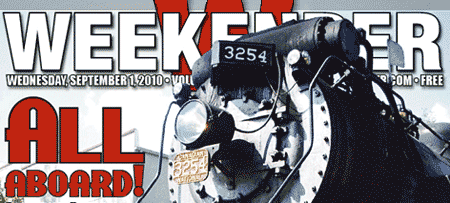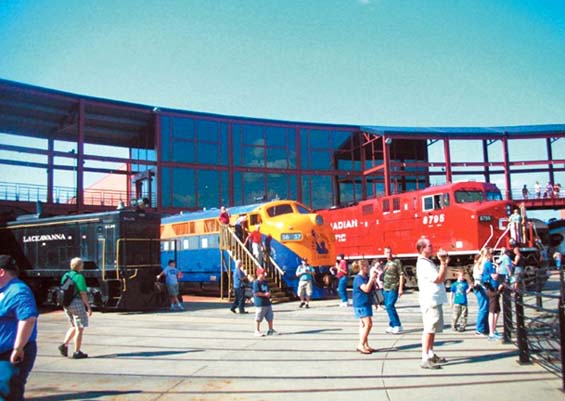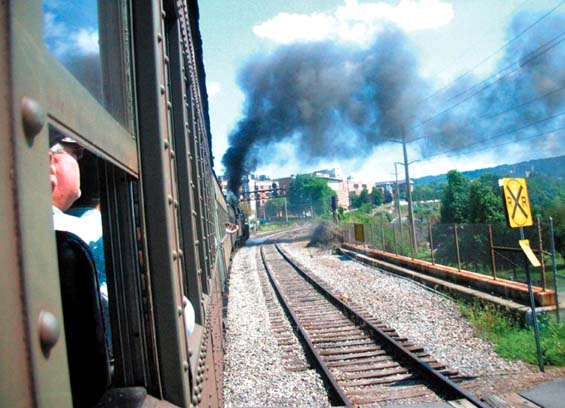Back
|  1 September 2010 On the Right Track 
Visitors attending last year's Railfest at Steamtown.
Scranton Pennsylvania USA - Nothing sounds like a train. From its whistle and clanging bell to the screech of its wheels on the track, it's a sound unlike any other.
It's the sound of America's past, it's the sound that railfans, people who live and breath all things train, relish in, and it's the sound that Mark Brennan hears every day at Scranton's Steamtown National Historic Site.
Brennan, the chief of Visitor Services & Public Affairs for Steamtown National Historic Site (SNHS), met with the Weekender last week to discuss the site's fourth annual Railfest, which will be held Saturday and Sunday, 4-5 Sep 2010. This year's theme is Passenger Rail Past and Present.
"We wanted to highlight passenger rail service," Brennan said. "The past, of course, we've got covered with our own equipment."
Steamtown is rich with railroad history. The site is on the former Scranton yards of the Delaware, Lackawanna & Western Railroad, which connected Northeastern Pennsylvania to Hoboken, New Jersey, and Buffalo, and Oswego, New York. In 1960, DL&W merged with Erie Railroad to form the Erie Lackawanna Railroad, which was absorbed into Conrail in 1976. Coincidentally, Brennan, who has been at SNHS for 22 years, was an engineer and manager for Erie Lackawanna when Steamtown was still an active railroad site, as well as the Delaware & Hudson Railway before that company went bankrupt in the late 1980s. He returned to Scranton just as Steamtown was getting off its feet as a historic site.
Steamtown is built around a working replica turntable and roundhouse, a building used to service locomotives, that has two sections which were built in 1902 and 1937. Three of the site's operational locomotives will be running during Railfest, as will two diesel engines that are on loan.
On Friday, one of two newly restored Lackawanna F3As was already on display at Steamtown, the other was still in the roundhouse getting its finishing touches for this weekend's event. While Brennan said it's possible the two may someday be used for excursions, right now they will just be on display.
"Railfest is the biggest event we do all year," he said. "I think it's important because it shows people several things. One, it shows them how important steam railroading was to the development of the country. Secondly, a lot of people think railroading is a past, dead thing, and it's really not. It's growing, it's thriving every day."
That is something that can be seen as the "present" portion of Railfest. Amtrak will be on site with an engine and some passenger cars, and Brennan said there will also be a few diesel locomotives on display that were used in the 1940s and 1950s for passenger trains. He shared that Railfest organizers are hoping New Jersey Transit will be in attendance with a brand-new train set, but that "is not 100 percent confirmed yet."
Other exhibits include a Canadian Pacific container car that was signed by its employees as part of last winter's Olympics, a Norfolk Southern car with a locomotive simulator inside of it and model LEGO train displays.
There is also a sold-out Whistle Stop excursion, which runs from East Stroudsburg to Scranton with a stop in Cresco. The Electric City Trolley Museum will run trolleys all day long around the site and to La Festa Italiana, which will be held Saturday-Monday on the city's Courthouse Square. The Whistle Stop will depart for East Stroudsburg around 4 p.m.
"We also have short train rides with a steam engine around the yard and caboose rides, people often don't get to ride in the caboose," Brennan said.
Entertainment for the event includes Ron Lea's Big Band, the Vince Brust Dancers, who will do World War II music and dancing on Saturday, and Ray Owen's "Casey Jones and the Great American Railroad" program on Sunday.

Riding the Scranton Limited at Steamtown.
MONEY TRAIN
In its inaugural year, Railfest saw about 2,000 attendees.
"Last year, we had a little over 4,000," Brennan said. "We hope and expect a little more this year."
While he said the park's budget has "been pretty stable," Brennan is expecting about a 10 percent decrease in funding next year. Steamtown received $1.5 million in stimulus funding as part of the American Recovery and Reinvestment Act of 2009 to remove the asbestos from 10 locomotives and 17 passenger cars.
"Before, we couldn't touch them, now we can start to cosmetically restore them," Brennan said.
Naturally, the economy has affected many aspects of leisure activities and travel nationwide, but Steamtown has benefited from the economic downturn.
"One of the things we've found is probably so overused now, but the "staycation" people bring a lot of day-trippers to the area," Brennan said. "We have seen an increase in that kind of traffic."
As guests walk around SNHS this weekend looking at displays, taking part in guided and self-guided tours, and taking short steam-powered rides, they may also see train cars still in disrepair that will someday endure their own restoration process.
"We have a pretty sophisticated process to do condition assessments on all of them, we know what it would cost to restore all of them, and we have that money in a system, which is millions and millions of dollars that is extra money above and beyond our operating budget," Brennan said. "The problem, of course, is every other park in the country has their systems, so it's a waiting game."
RESTORING HISTORY
An important part of SNHS is its History Museum and Technology Museum, but an equally vital part of preserving Scranton's rich railroading history is the site's expansive restoration shop, part of which will be open to the public during Railfest. The shop features a new crane and a restored welding area, which Steamtown "invested a lot into it, and we can really get a lot of work done," Brennan said.
Visitors can walk around the still-being-restored Baldwin No. 26 locomotive engine, which is expected to be finished sometime next year, and the Boston & Maine No. 3713. When finished, the latter will be the first American engine at Steamtown to be restored to working order.
"(It's) coming along slow but sure," Brennan said of No. 3713, explaining that the project is funded by the Lackawanna Wyoming Valley Chapter of the National Railroad Historical Society. "It's moving along slower than we would like, but it's a monumental task. You can get the money in place to have everything you need for it, but to get the people who have the knowledge to work on it, and do it right, is the hard part, but we are making quite a bit of progress on it."
There is one impressive engine on property that visitors to Railfest won't get to see quite yet: The Nickel Plate Road No. 759, which is still undergoing its asbestos removal. It was one of 80 engines purchased by the Nickel Plate Road (formally the New York, Chicago & St. Louis Railroad) between 1934 and 1949, and is one of only six surviving locomotives of its kind.
"It's my favorite," Brennan shared. "It's big, and it can run long distances, like from here to Hoboken, N.J., on one shot."
While some might consider railroads a dying industry, they might be surprised to learn the average age of a SNHS steam mechanic is between 35-40. Brennan said there are about 15 mechanics who are supplemented by nearly 60 volunteers.
"Volunteers who are interested in learning that craft volunteer in the shop and work with these guys, and that craft has passed on to them over a period of years," he said.
Throughout the restoration shop, in the areas that will and will not be open to the public this weekend, are the things that make refurbishments possible: An endless supply of parts, tools, and equipment, like the vast nuts and bolts room in the main restoration area, or the bin of drill bits that was out in the roundhouse. In a back room of the roundhouse, a bell, which Brennan believed to be from the Delaware, Lackawanna & Western No. 565 engine, sat amid other unused parts waiting for its turn to be used again someday.
"It's all about parts, there's lots of parts and equipment," Brennan said. "We can't go to Kmart and pick something up, so we manufacture 60 percent of our parts here."
During SNHS' park hours, visitors can watch work being done on the engines in the roundhouse.
"This is the only place in the country where people can watch work being done on engines from a close but safe distance," Brennan said.
Nikki M. Mascali.

|

